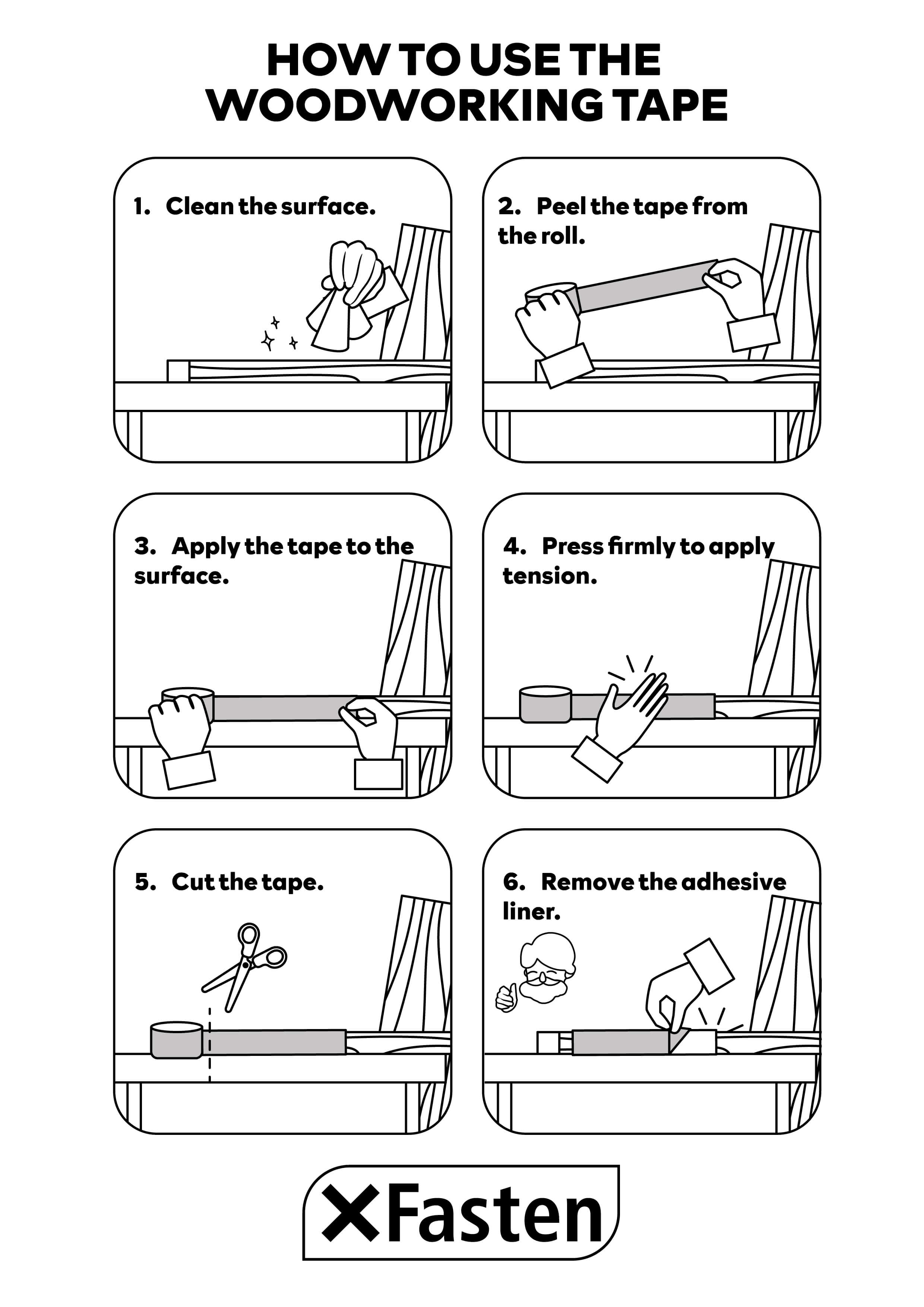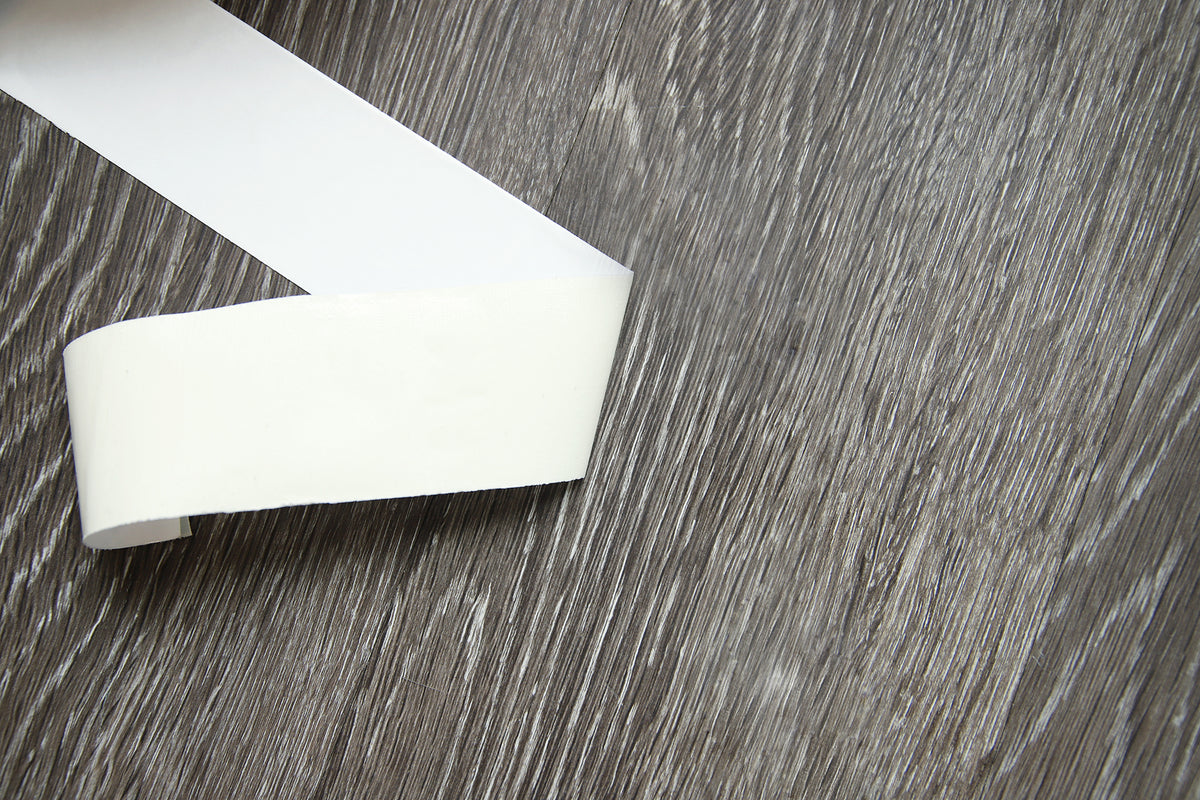
INSTRUCTIONS
- Clean both surfaces where you would be installing the tape. Lint, dirt, and dust can significantly lessen the bonding strength of adhesives.
- Peel the tape from the roll. Do not cut the strip first.
- Apply the tape on the surface, with the other end still spooled on the roll.
- Apply some tension by slightly pulling the roll, then cut the tape. The tension will make the tape easier to cut.
- IMPORTANT: Remove the adhesive liner. To separate the adhesive liner easily, you can use any flat tipped object like a card, knife’s edge or your fingernail to create an initial gap between the liner and the tape.
- Apply more strips by repeating steps 2-5.
Peeling the Adhesive Liner
You could use any flat tipped object like your nail or a thin card to initially create a small gap which can be fully peeked to release the liner. The Double-sided Woodworking Tape’s adhesive liner is yellow in color while the adhesive tape itself is cream/white. The adhesive liner needs to be removed to expose the sticky side. Also, to improve the bonding strength, it is recommended to apply as much tape as possible as the surface area allows.
Improving Bonding Strength
- You can increase the bonding strength by pressing it against the surface. Make sure to press it firmly through your hands or palm. Squeegee any air bubbles or gaps that may exist between the surface and the tape.
- If you have a hair dryer or a heat gun, you can also heat the adhesive using its warm air exhaust. Heating the adhesive upon installation will temper it and further increase the adhesive’s strength.
- Increasing the surface area of application by applying more strips on the object that is to be mounted will also increase the weight holding capacity.
Cutting the Woodworking Tape
If you have trouble tearing/cutting the tape, then it is recommended to apply some form of tension on the tape by pulling it gently while one end is installed on the surface while the other end is still spooled in the roll. By pulling the tape and applying some tension, it will be easier to cut or tear the strip.
Removing the Adhesive
On rare cases, the adhesive can stick into objects such as the edge of a scissor. The adhesive can be easily removed by either of the following steps:
- Partially melting the adhesive using the warm air exhaust of a hairdryer or a heat gun. Warm air will soften the adhesive and thus make it easier for you to remove any adhesive residue. After partially melting the adhesive, then you can simply wipe off the adhesive residue.
- Wiping the surface with warm water with soap and white vinegar solution. You can also use a soft brush to remove the adhesive faster. You can also mix in some baking soda to the solution.
- Applying Goo Gone solution, lighter fluid, or kerosene on the surface. This will melt the adhesive without damaging the surface. Soak the surface for 15 minutes and simply wipe it off with a damp cloth. The residue can easily be removed and wiped clean through this process.
Important Note for sensitive wood panel surfaces:
There are cases where the woodworking tape might lift off some fibers, especially if the surface is soft. If you feel that the adhesive is too strong or that the wood finish is too delicate or soft, then we recommend the following steps to ensure that the woodworking tape will not lift off any surface finish:
- Adhere the woodworking tape first on a cloth or cotton surface for 5-10 seconds.
- Press the tape a few times before removing it from the cloth surface.
- Install it on the wood panel’s surface.
Adhering the tape on a cloth or cotton surface first before to a panel of wood will make the adhesive less aggressive, thus preventing it from lifting off or damaging the surface. This is the same technique that painters employ on Masking Tapes when working with delicate surfaces such as a watercolor paper.
Blog Feature
How To Remove Adhesive Residues in Less Than 5 Minutes
Are you having trouble relocating your carpet, area rugs, and other home furniture because of messy and stubborn residues? Here, you'll learn different tried and tested ideas in removing these stubborn and very sticky residues from adhesives. You'll also have to consider that the tape will not damage the surface of your expensive furniture or hardwood floor when you finally remove it.


